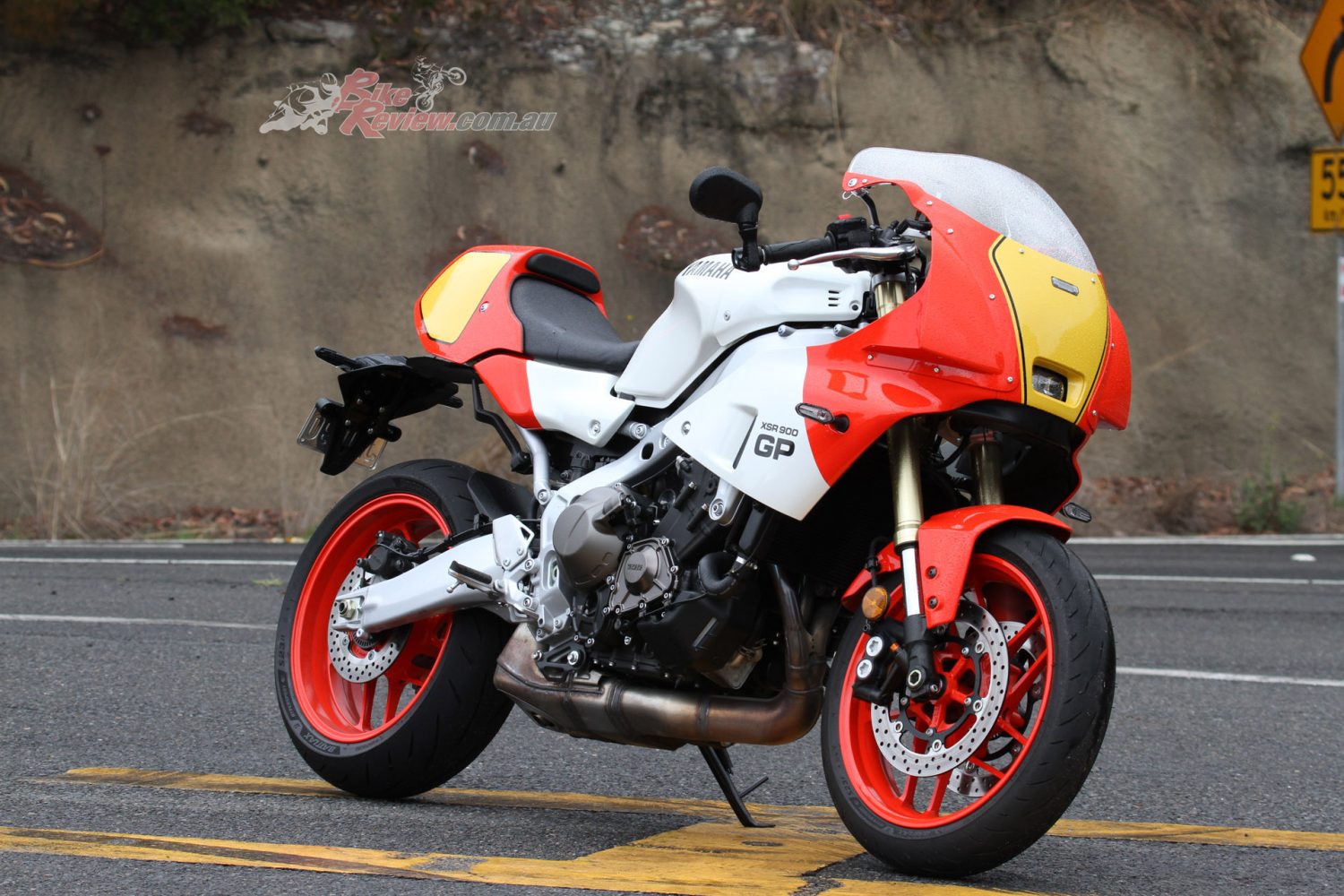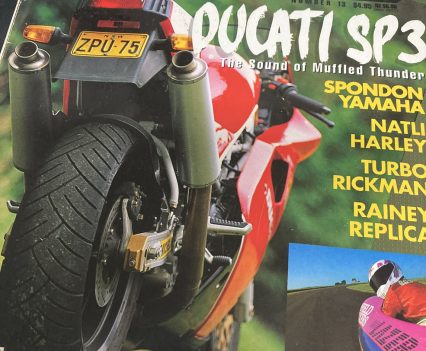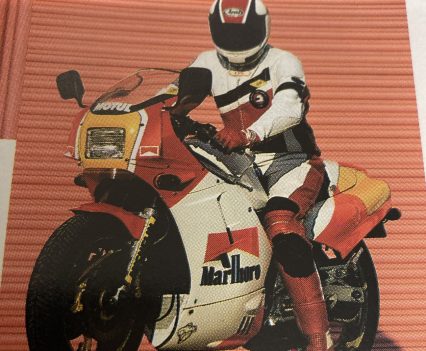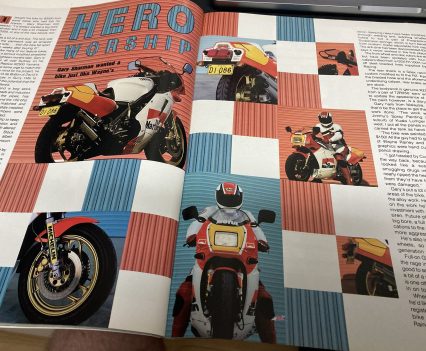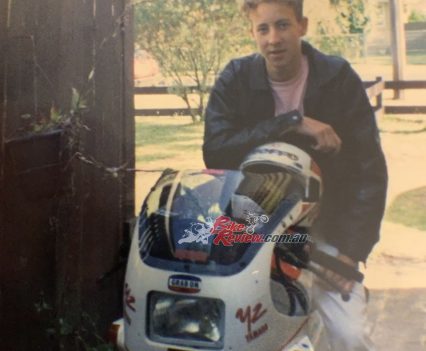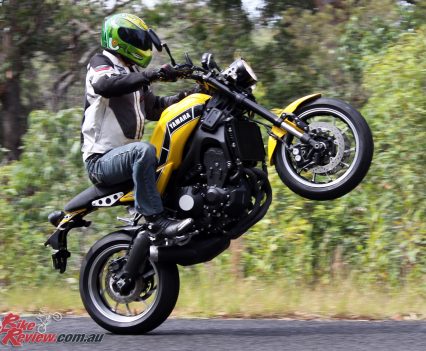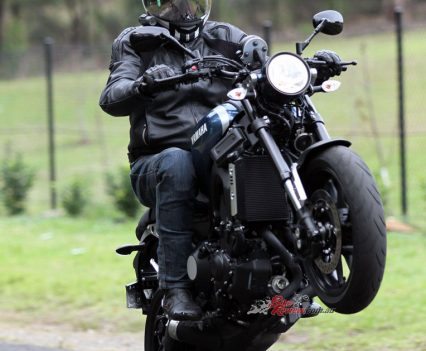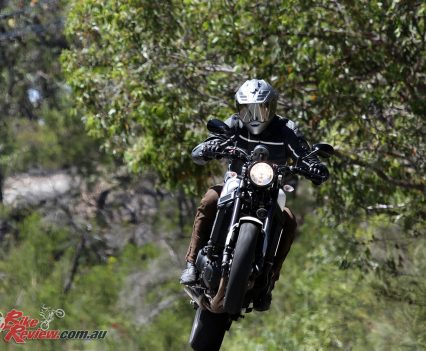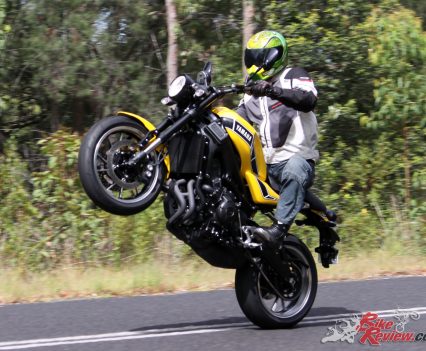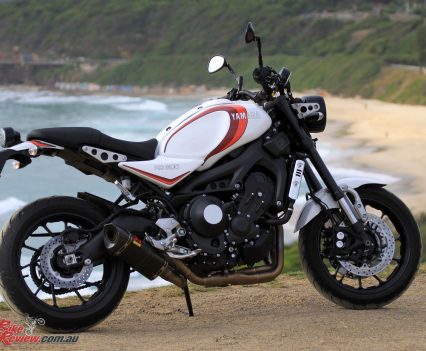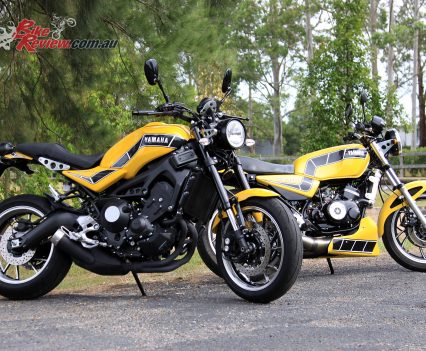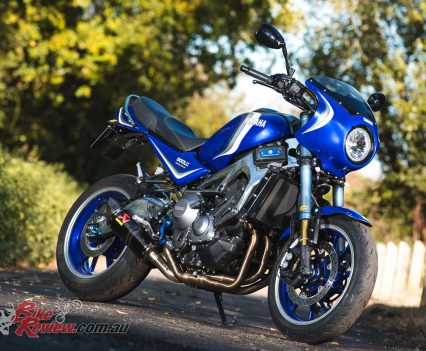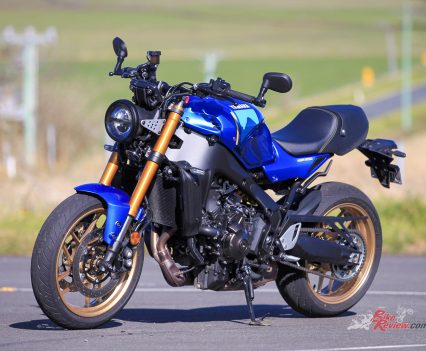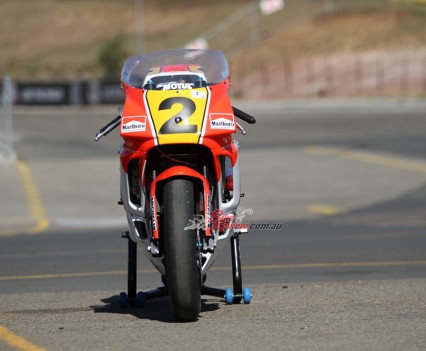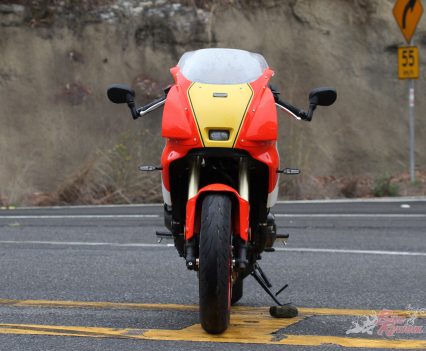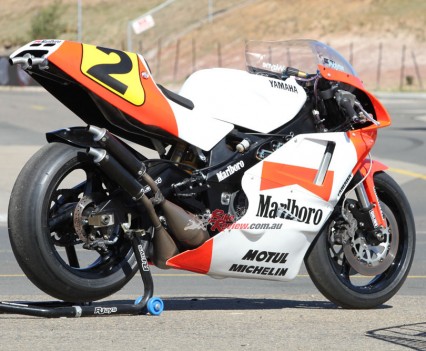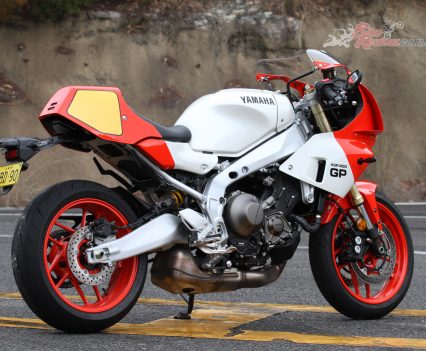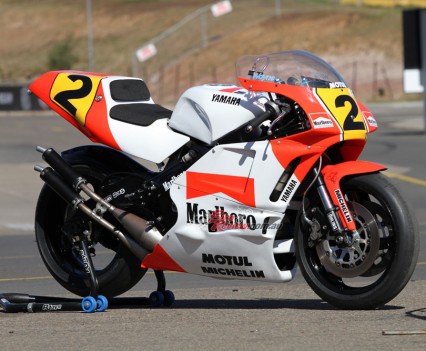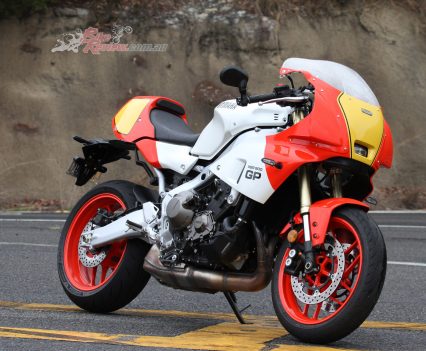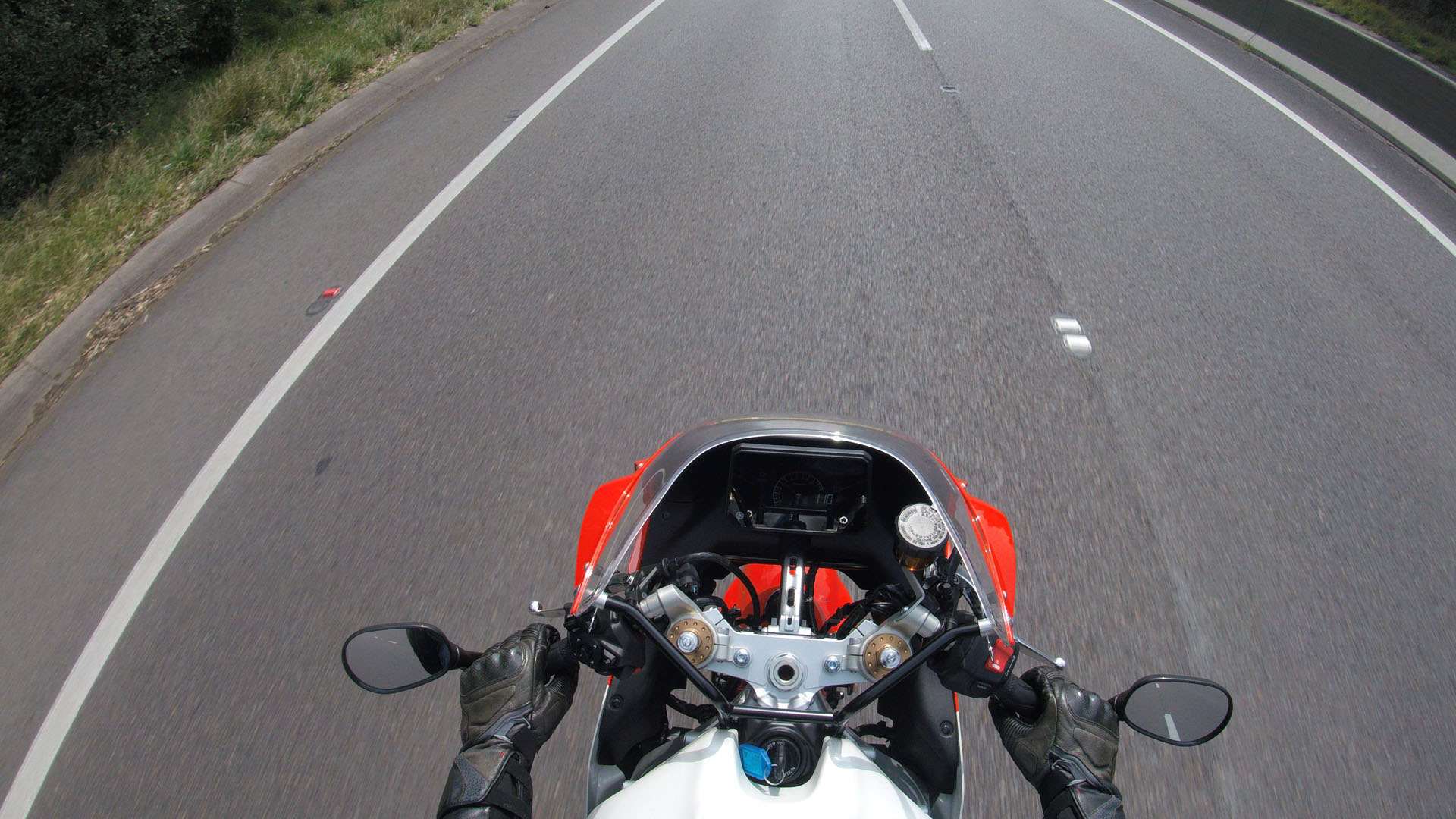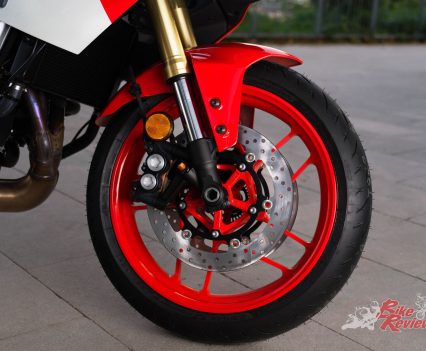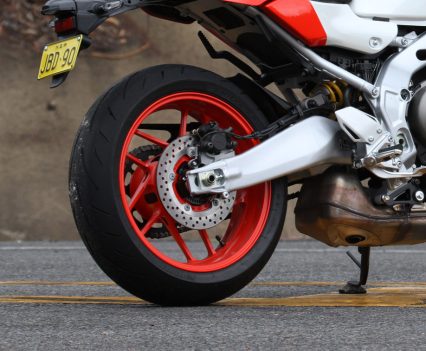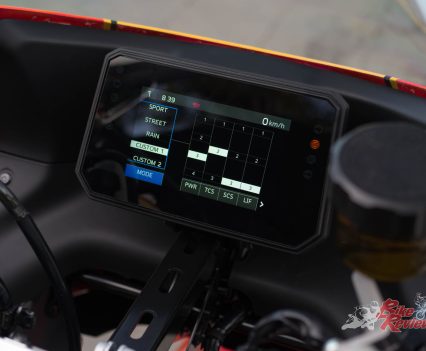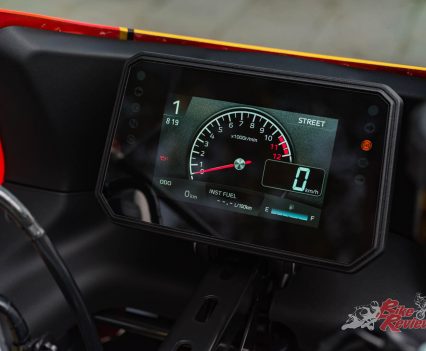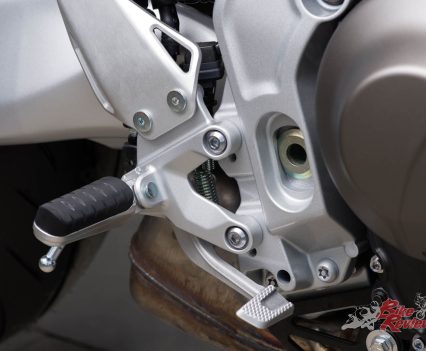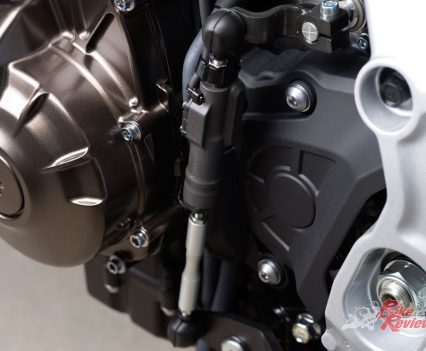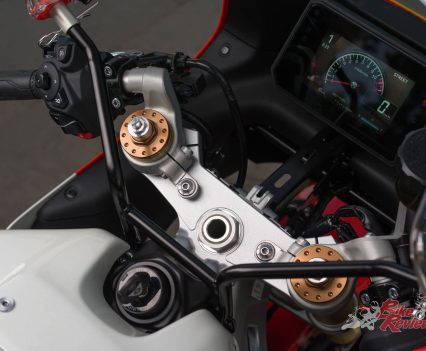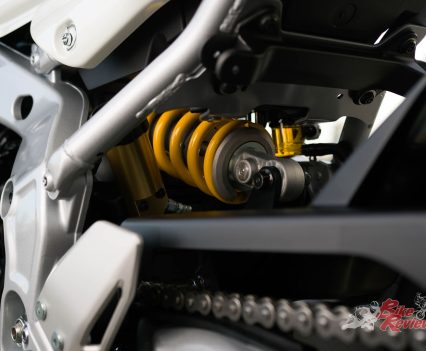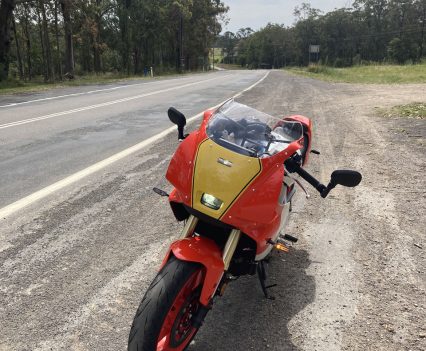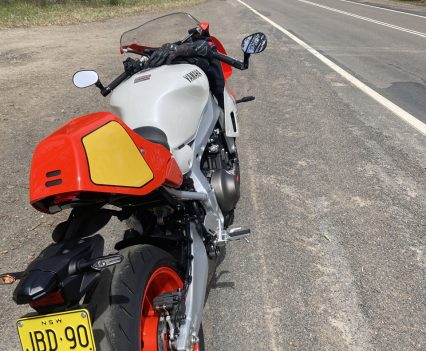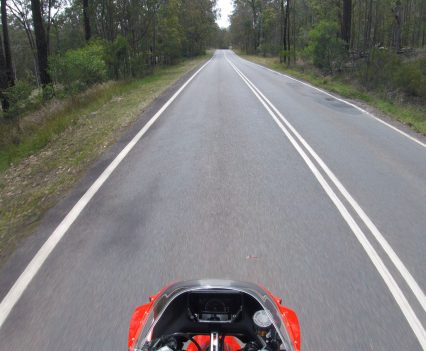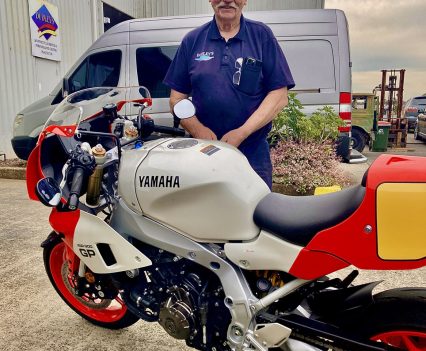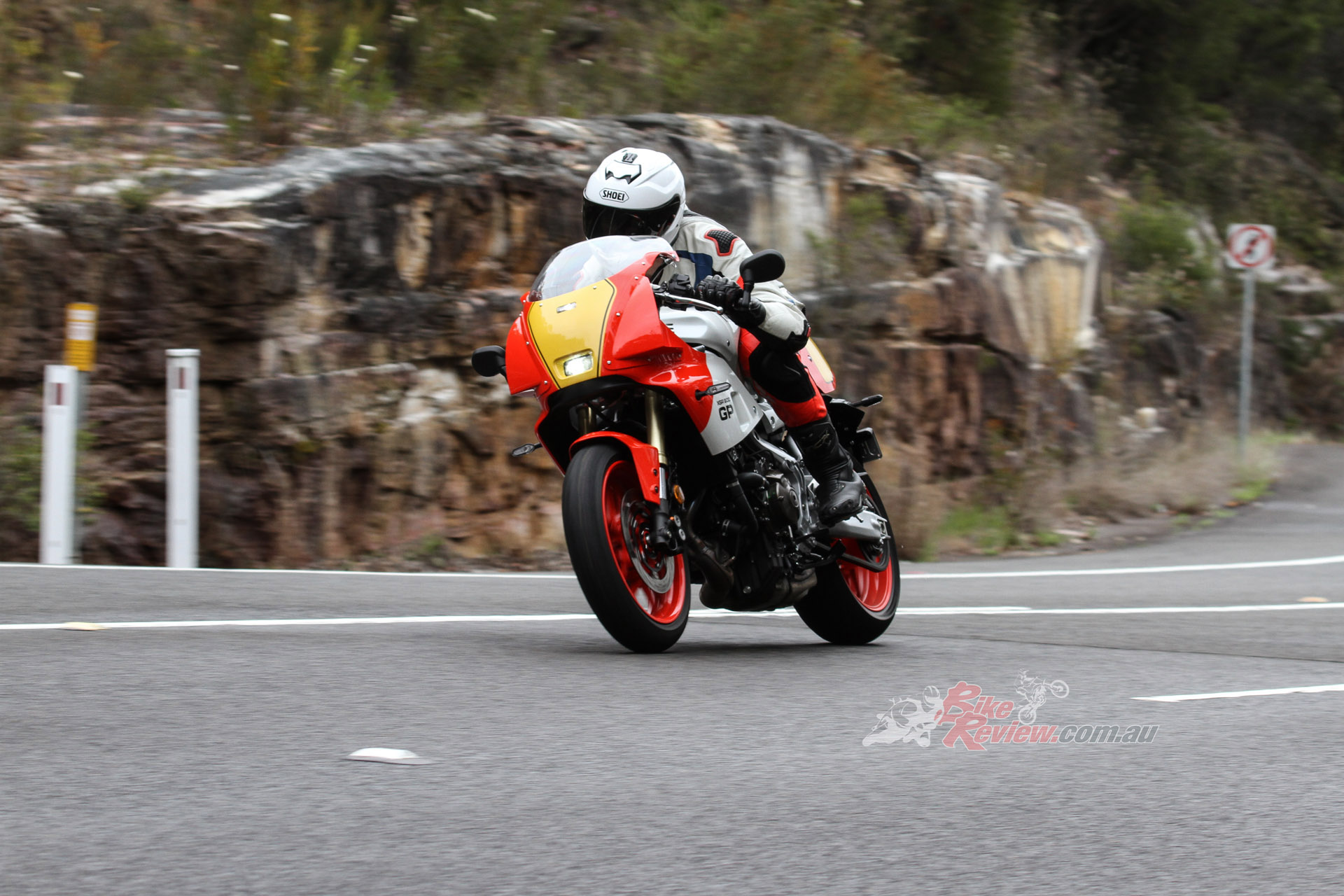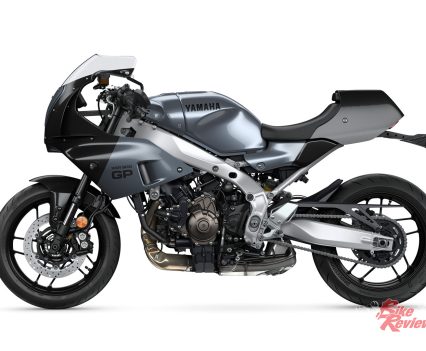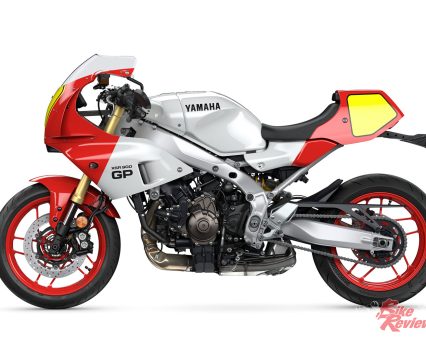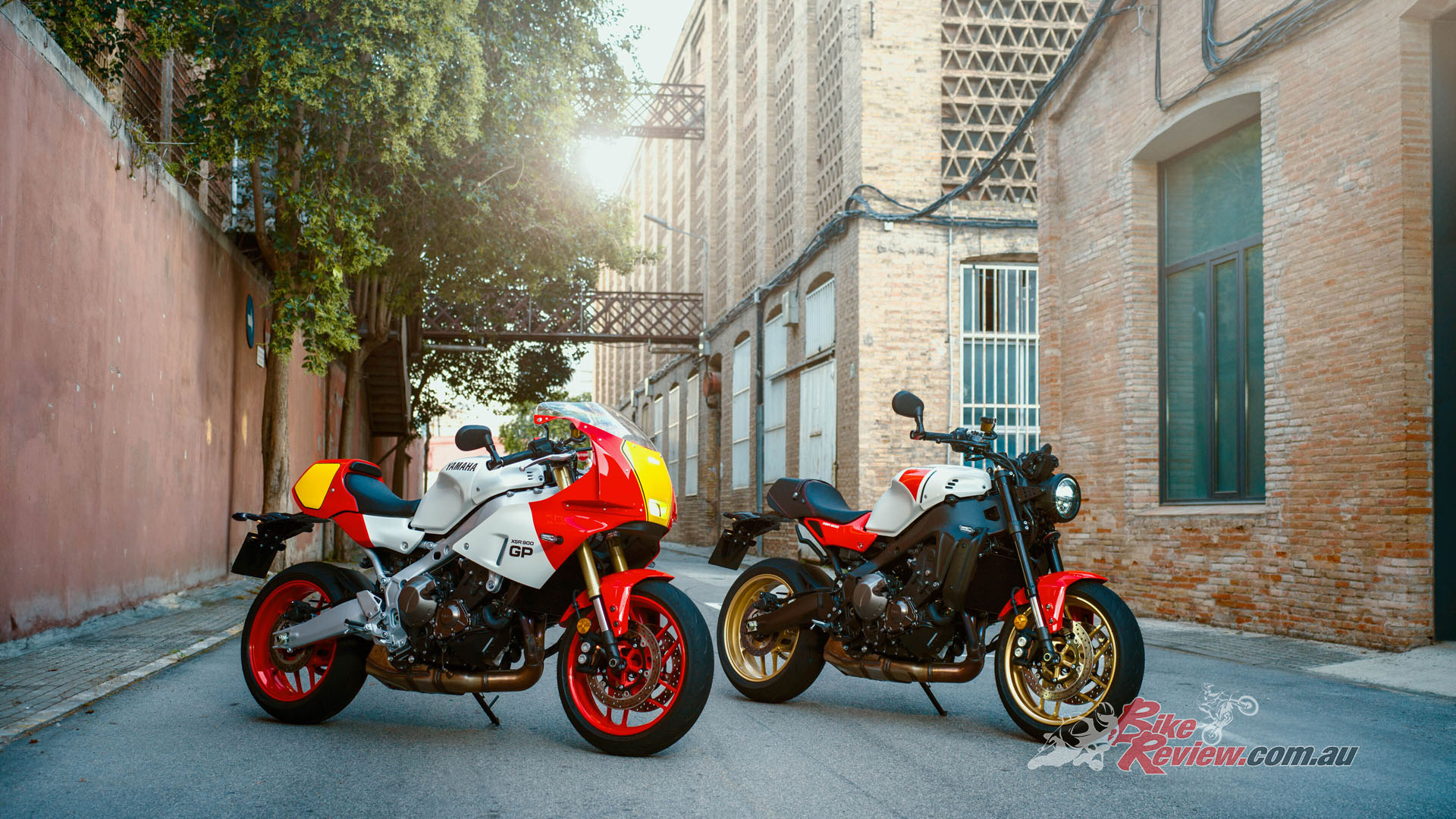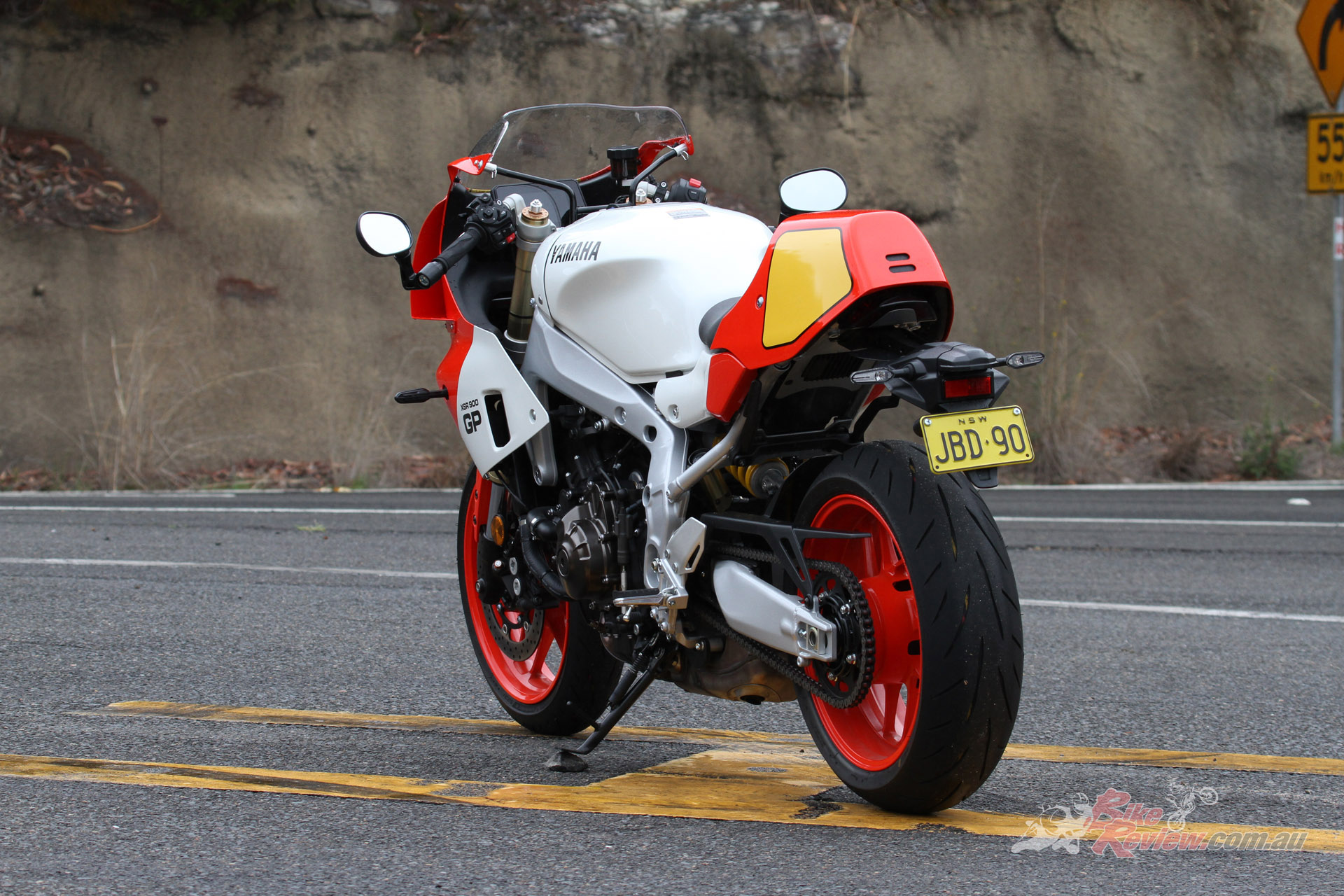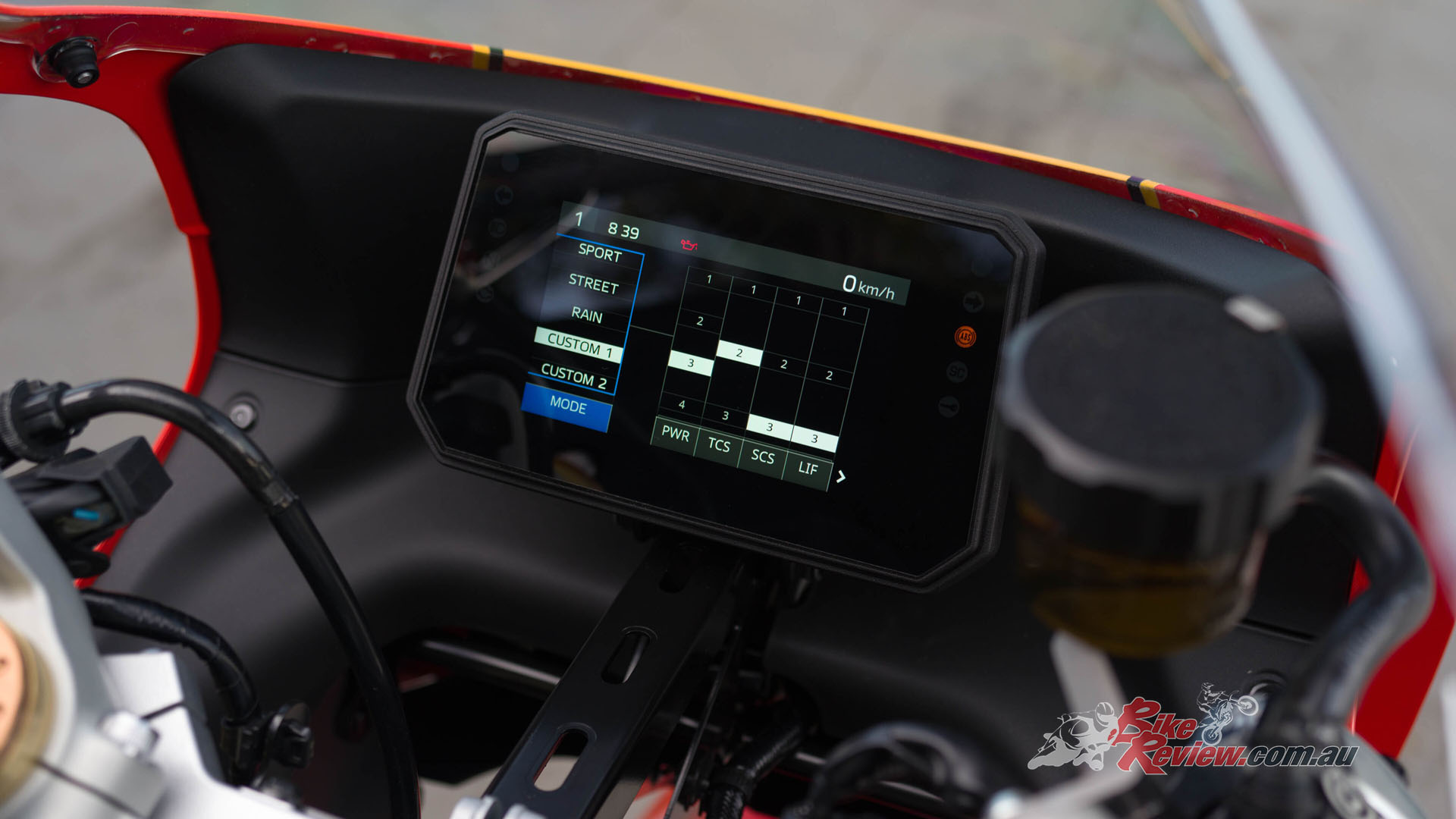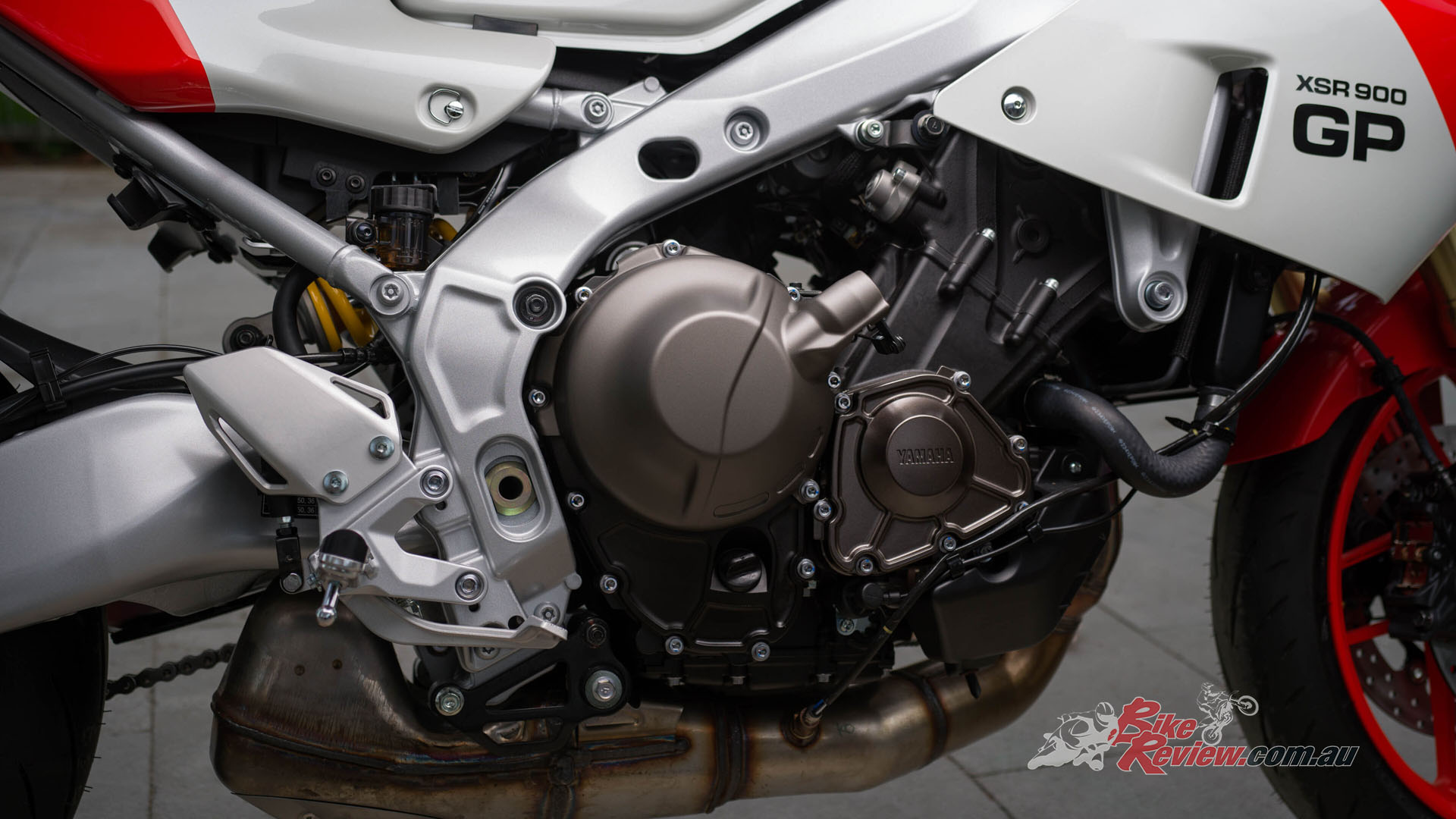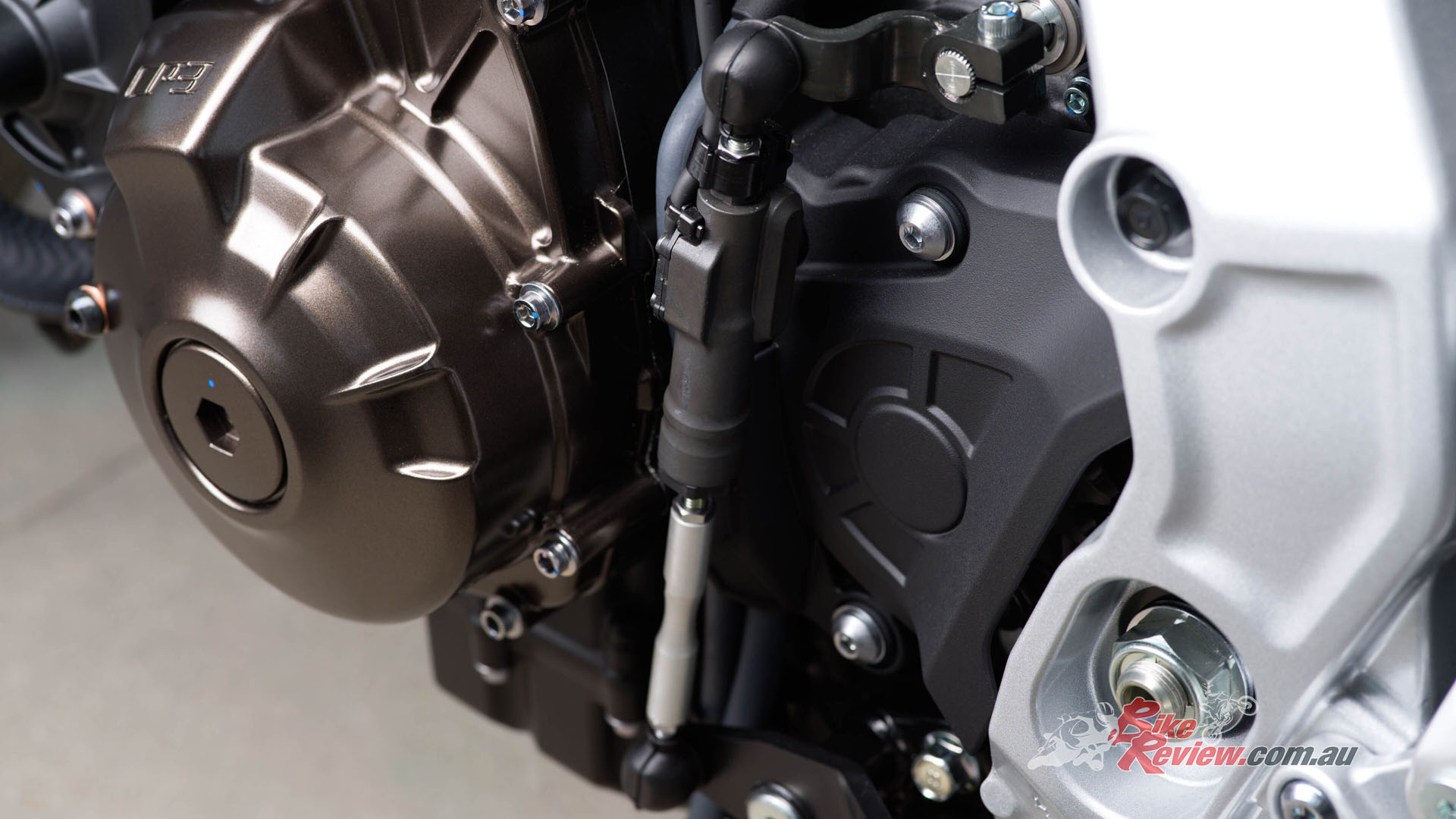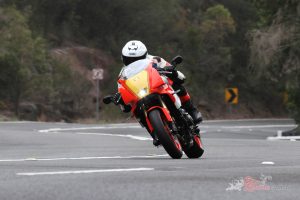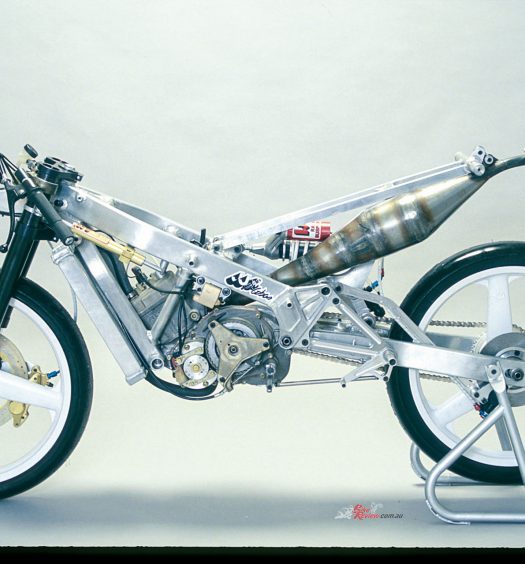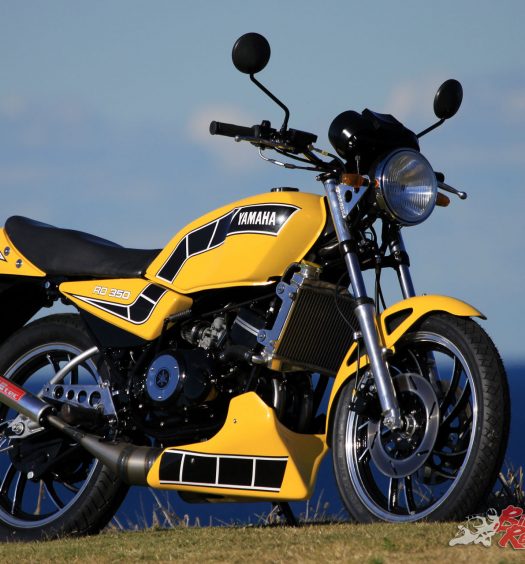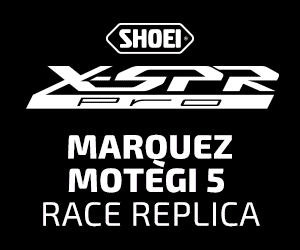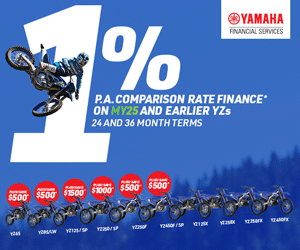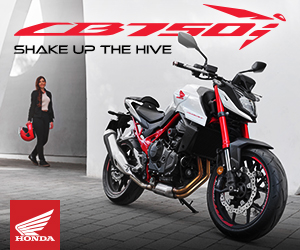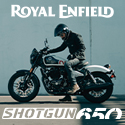The XSR900 GP takes our Ed back in time to relive his teenage years riding his RZ250 and TZR250, dreaming of owning a Marboro Yamaha Replica RZ500... Photos: Heather Ware HMC
If there’s ever been a bike that blends the glory days of road racing with modern tech, it’s the Yamaha XSR900 GP. Inspired by Yamaha’s Grand Prix heritage and heavily influenced by the ’80s and ’90s racebikes, this GP edition isn’t just a nod to nostalgia, as we discover…
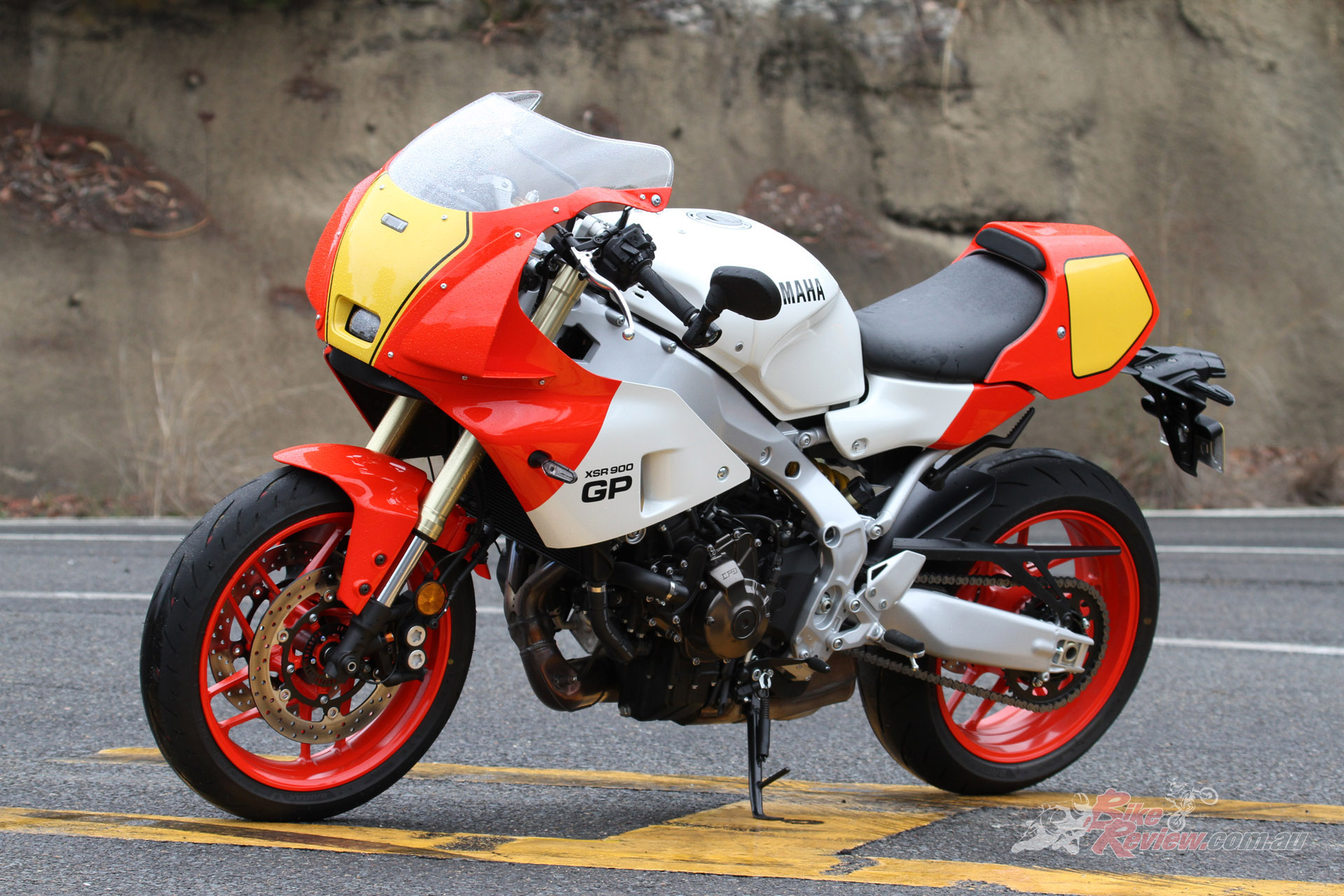
What do you see when you look at the XSR900 GP? We see TRX850 meets FZR1000 OWO1 meets TZR250 and XSR!
As soon as I fired up the laptop to write this XSR900 GP review, Streetbike Magazine issue #13 sprung to mind, so I dug it out of my archives. I was so obsessed by the Marlboro RZ500 featured when I was in year 12 and had an RZ250, then a TZR250, that I must have read the story a million times, so much that the issue of the mag must be etched into my memory even 30 years later.
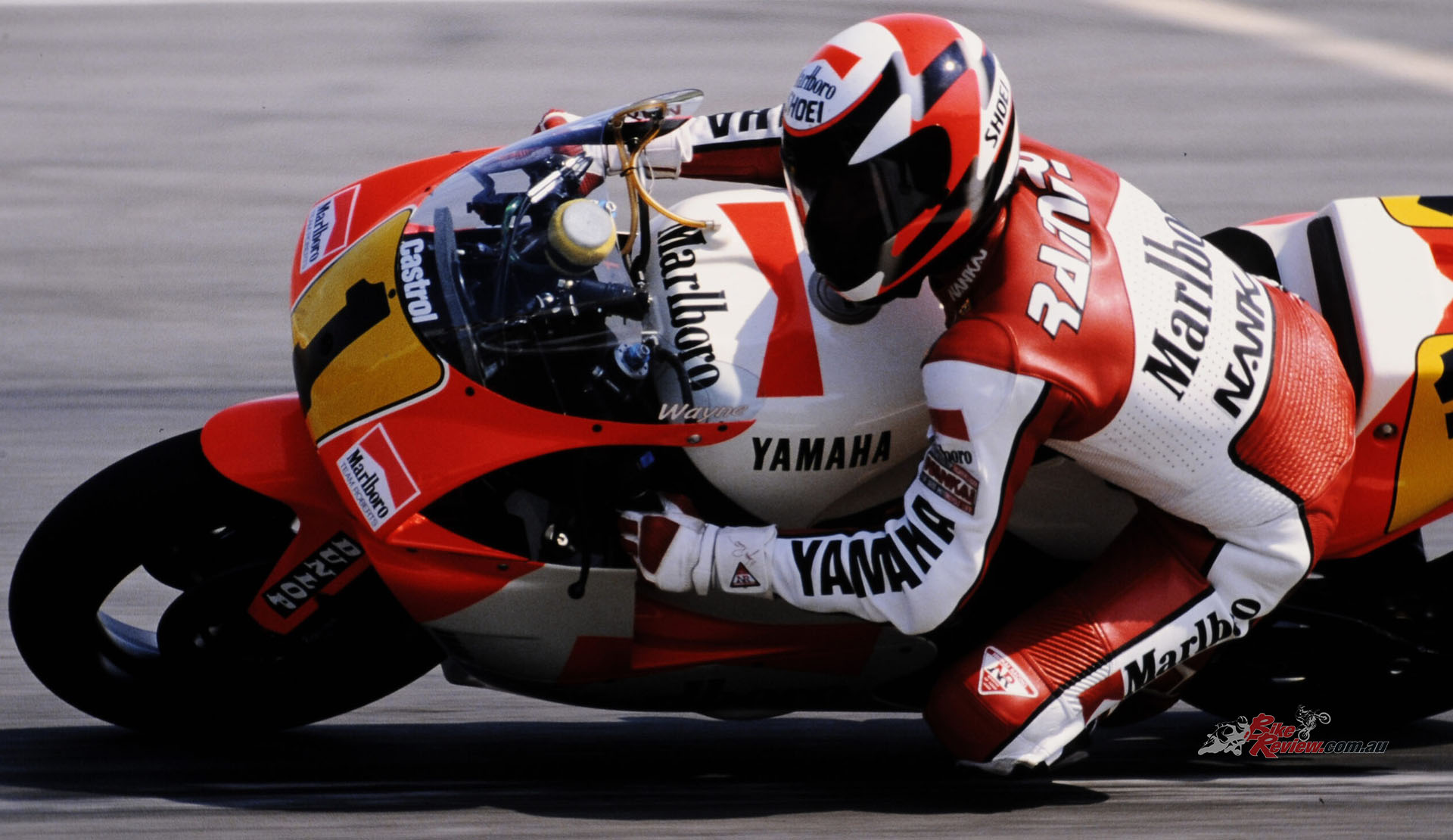
I left school and was a young motorcycle mechanic apprentice at Willing M/C, learning under the watchful eye of ex Marlboro Yamaha Team Boss and Mick Doohan mechanic, Dudley Lister. My boss was Australian 500cc GP Champion Len Willing, the Marlboro Yamaha orange wheels from Mick Doohan’s FZR were on the tyre rack, they belonged to Glenn Willing, and Warren Willing, then Marlboro Yamaha 500 Team Boss, would call the shop after each race weekend to discuss the weekend with Len… I was right in the thick of it and a big dreamer… Yep, I’m one of the late 40s early 50s somethings riders who immediately click with the XSR900 GP looks…
Under the skin, however, it’s still the brilliant XSR900 we know and love, wrapped in a fairing that turns heads, stirs souls and looks every bit the part of a pit lane weapon of years gone by. After spending over 1000km in the seat, including fast country blasts, mountain twisties, urban commuting and a 400km highway run from the Central Coast to Stroud and back, I can confidently say the XSR900 GP isn’t just a looker, it’s one of the best all-rounder sportsters Yamaha has ever produced. We’ve tested a bunch of XSR900s, from the Kenny Roberts and RD LC replicas to the stock ones of 2017 and 2022.
Check out our Yamaha XSR900 archives here…
While the standard XSR performance was always solid, the styling never quite spoke to me personally. But throw on a bubble fairing, an aggressive 1990s styled tail, some heritage livery, and my inner teenage road-racing tragic just can’t say no. The XSR900 GP presses every emotional button… then backs it up with an awesome ride that proves it’s more than just a pretty face…
The most obvious change for the model is the full front cowl. And what a difference it makes. From every angle, the GP looks like it’s ready to rip around Oran Park with Mick Doohan in pursuit on the #25 1987 Marlboro FZR. That square, race-style fairing gives it a proper ‘factory’ look that’s more YZR than MT, and the elongated tail unit completes the silhouette perfectly. The LED headlight sits neatly inside a classic lens cutout, giving a subtle blend of modern and vintage, almost a bit endurance-like.
Yamaha have nailed the little details, too. The Legend Red colours scream 1980s GP paddock, and the rearsets, bar-end mirrors, clip-on handlebars and custom seat all add to the bespoke racer vibe. The triple-clamp is specific to this GP edition, with the top fairing stay having anodised alloy fixtures with R-Clips that look so racer original and very 1980s/1990s. I really love it…
Despite its retro looks, the finish is all business. Paint quality is top-notch, welds are clean, and the fairing is properly integrated, not just bolted on like an afterthought. It’s more than just a styling exercise. It feels intentional, refined, and authentic. To me, it channels the spirit of the FZR1000 and TRX850 in one swoop, the kind of design that speaks directly to the heart of ’90s sportsbike tragics.
Ergonomically, the GP is a fairly big step away from the standard XSR900. Gone is the wide motocross-style bar and relaxed upright riding position. In its place are low-ish, sporty clip-ons that sit above the top yoke, giving you a more aggressive, tucked-in position but one that suits us over 45s. It’s not a full-on race crouch, think 1990s supersport, not 2020s superbike, but it’s definitely a committed riding triangle compared to the nakedbike version. The rearsets are adjustable, they are set in the highest of two positions from the factory. I left them there, as it felt a bit sportier that way.
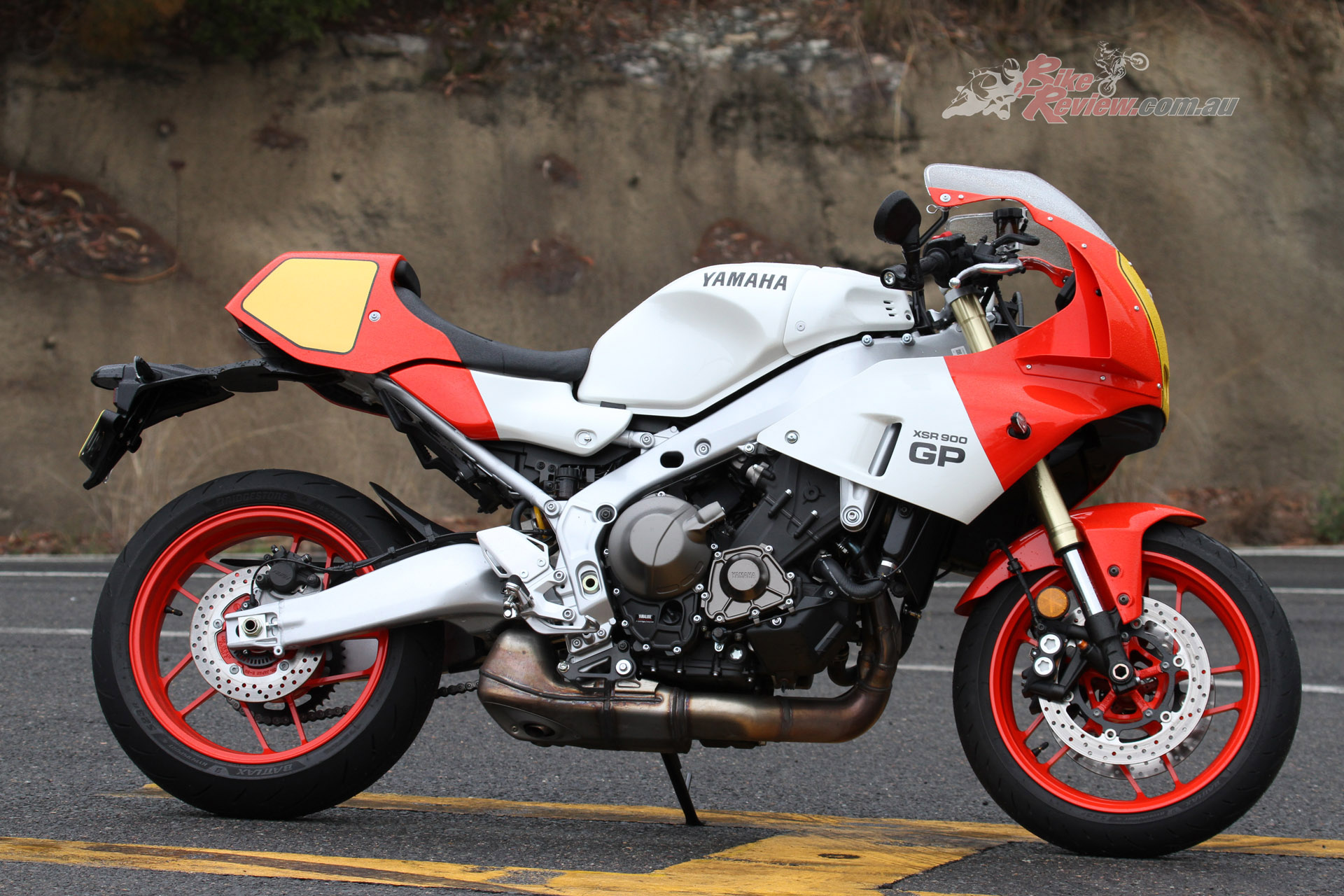
The XSR900 GP presses every emotional button… then backs it up with an awesome ride that proves it’s more than just a pretty face.
Yamaha moved the bars 93mm forward and 114mm lower, the seat 12mm forward and 27mm higher, and the ‘pegs 26mm higher and further back than the standard model. Combined with a 5mm taller headstock (and trail increased from 107mm to 110mm), these changes create a proper sporty triangle that encourages riding with intent, while still retaining a good level of comfort.
As a taller rider (I’m 187cm), I found the setup comfortable in al situations. The new seat is flatter and longer, allowing more movement, and while it’s not plush, it’s far from the torture bench some café racers fit as standard. You feel like you’re sitting in the bike rather than on it, especially with that big screen wrapping around you like an old-school GP fairing, it feels like an FZR600 or FZR1000, or even a YZF750 to me, as the tank sits up high and the screen is big.
That said, the 835mm seat height, combined with a tall centre of gravity and a restricted steering lock, means tight U-turns and parking maneuvers require some care. The GP leans over excessively on its sidestand, too, a result of Yamaha not lengthening the stand to compensate for the increased ride height. With a full tank, lifting it off the stand required more effort than it should. It’s a wide bike, too, with the handlebars and mirrors restricting lane splitting a fair bit in heavy traffic.
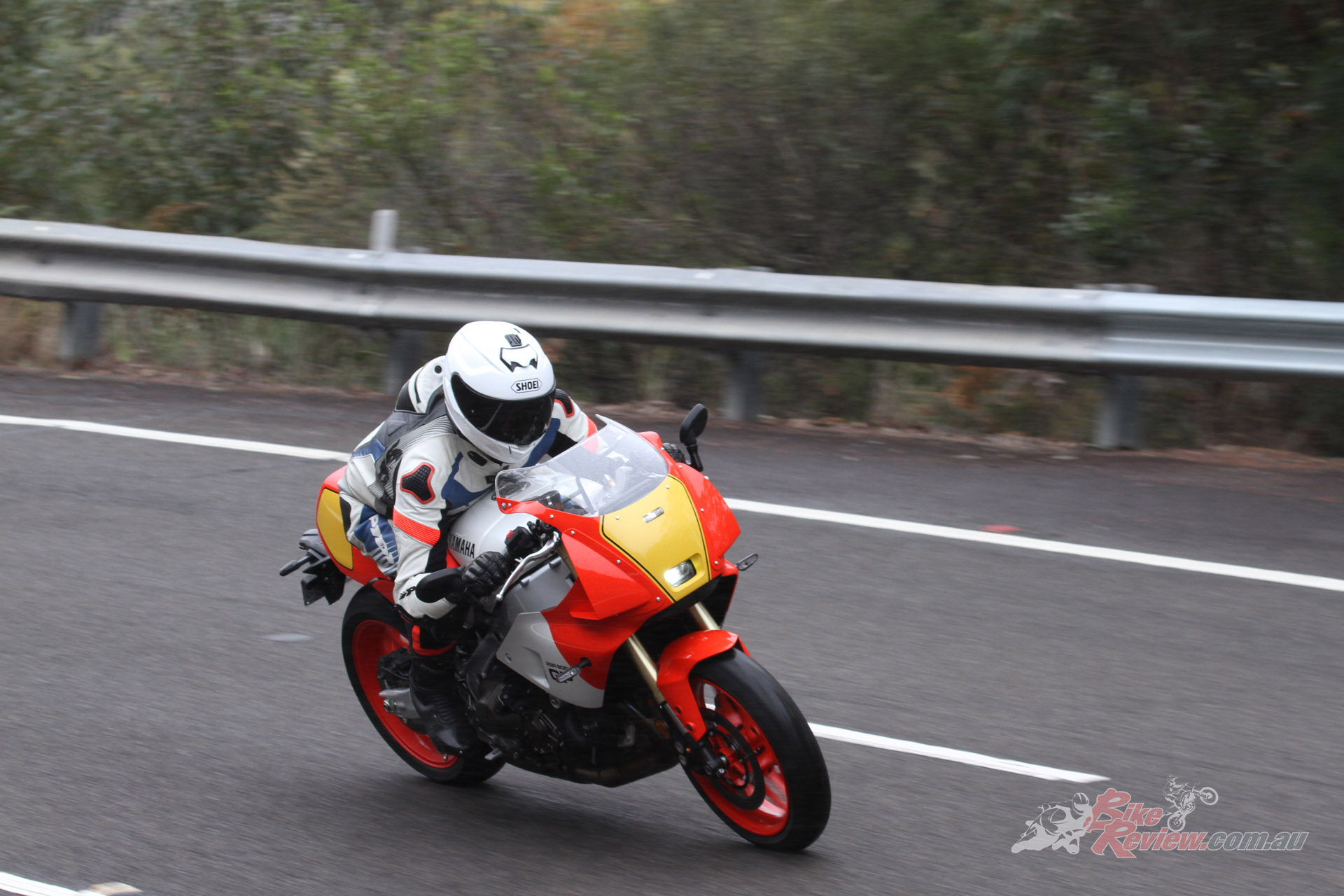
“It feels like an FZR600 or FZR1000, or even a YZF750 to me, as the tank sits up high and the screen is big”…
The 2024 XSR900 GP runs the same 889cc CP3 triple-cylinder engine found in the latest MT-09 and Tracer 9 GT. That means 117 horsepower and 93Nm of torque from an engine that feels alive in every part of the rev range. Yamaha’s crossplane concept delivers a barky, raw power delivery that makes the GP feel like a lightweight superbike with the soul of a two-stroke, that’s the best way I can descibe the ride experience from the CP3…
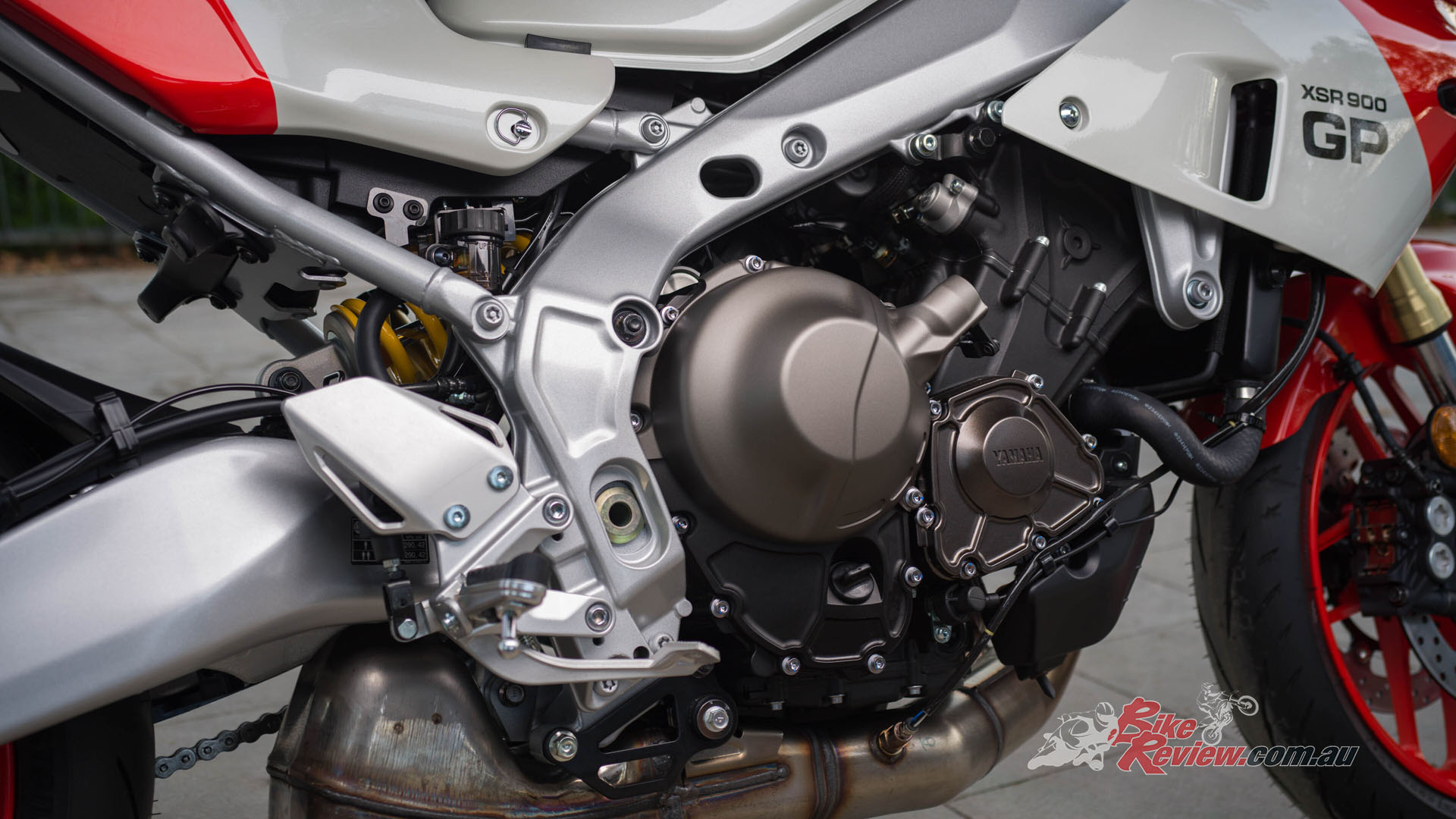
87.5kW@10,000rpm. 117 horsepower and 93Nm of torque from an engine that feels alive in every part of the rev range.
From 3000rpm onwards, it surges forward with linear aggression. There’s usable torque everywhere, but it’s the punch between 6000 and 9500rpm that really shines. That’s your sweet spot, twist the throttle there and the front goes light, the scenery blurs, and the soundtrack roars. It’s not intimidating, but it is thrilling enough and is super tractable.
The intake howl combined with the uneven firing order gives the XSR900 GP a sound like no other. The stock exhaust isn’t loud (there is an Akro available), but crack the throttle and it snarls like a little race bike. The induction noise is as addictive as it is mechanical. Swap the muffler for something fruitier and you’ll have one of the best-sounding road bikes out there. First stop for me would be Y-Shop.
Fuelling across all Ride Modes is excellent. Sport mode is the most direct, with sharp yet smooth response, and became my go-to for twisty backroads. The throttle is smooth, except off the very bottom, the the slipper clutch is well dialled in, allowing a good run-on speed into turns when downshifting. Around town the clutch action is light and progressive, making city riding or slow-speed work a doddle, and the bi-directional quick-shifter is good in town and out on the open road.
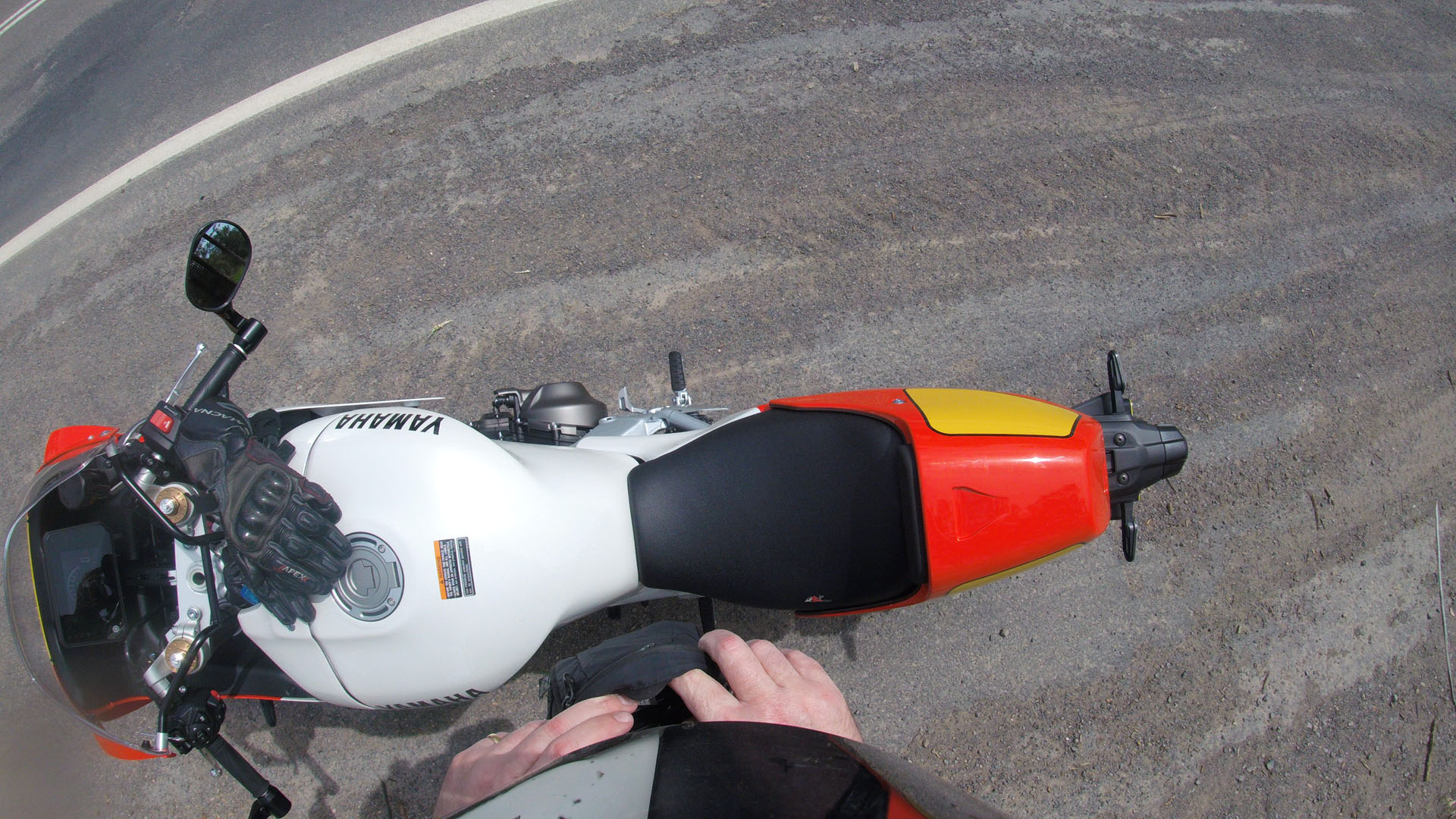
The XSR900 GP has a really narrow waistline but a wide tank and handlebars like the old FZR and OWO1 models we loved as young people!
It’s wild to think a retro-styled bike like this has electronics derived from Yamaha’s R1M. But here we are. The six-axis IMU gives you lean-sensitive traction control, slide control, wheelie control (LIF), cornering ABS and even a brake control system for hard trail-braking. And all of it works seamlessly in the background.
The new 5-inch TFT dash is crisp, clear and easy to navigate once you get your head around the menu system. You can customise Ride Modes, adjust your assists, and even hook up your phone via Bluetooth. Cruise control is included, as is the quick-shifter with auto-blip downshifts that makes backroad carving or city commuting that much smoother.
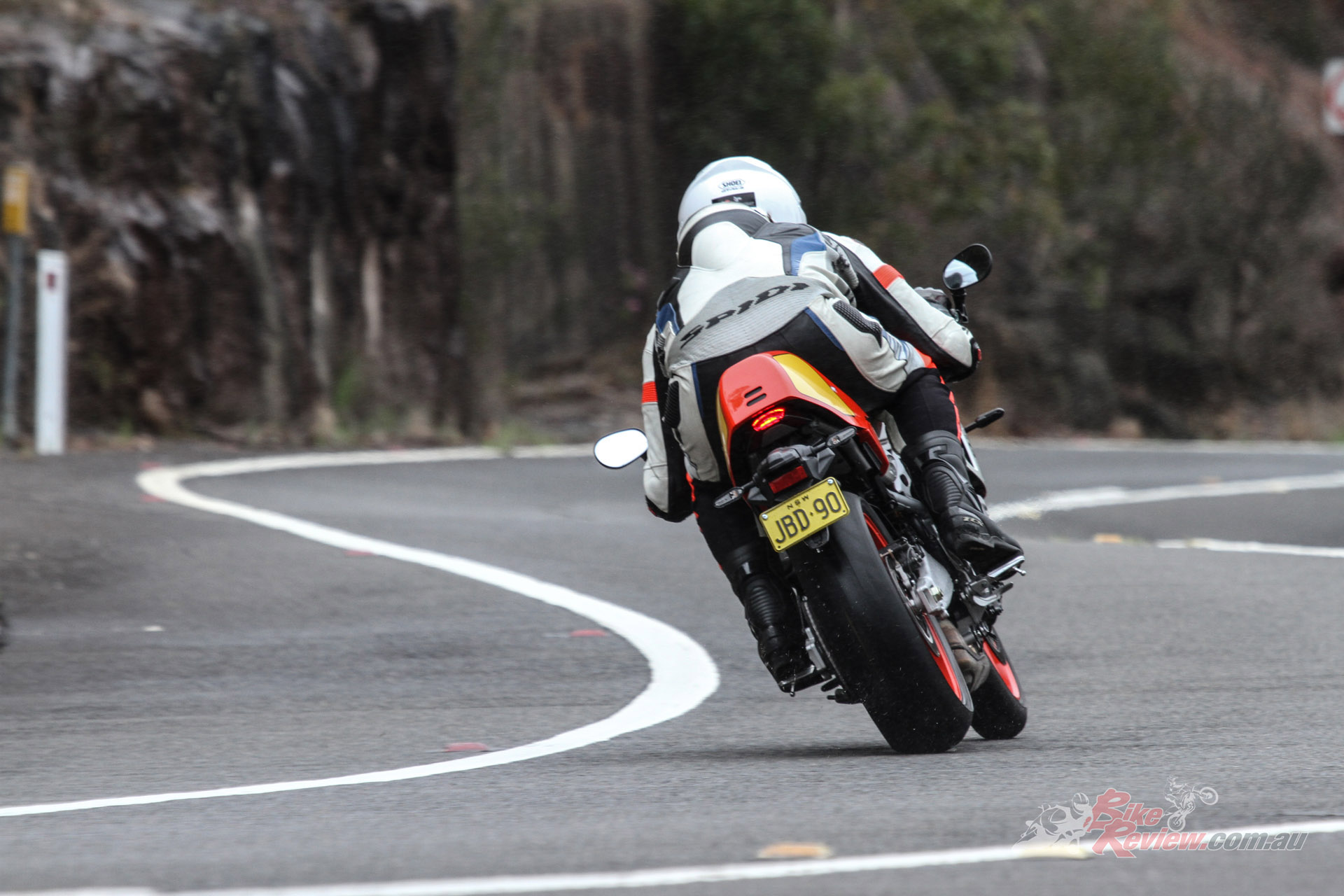
Three ride modes, Sport, Street and Rain, are complemented by the ability to create two custom modes.
Three ride modes, Sport, Street and Rain, are complemented by the ability to create two custom modes where you can fine-tune throttle response, traction control, and more. Sport gives you the full beans with a sharp throttle, while Rain softens everything and adds extra intervention. Custom 1 became my default mode for hard rides. If there’s a gripe, it’s the TFT display’s modern look. It’s highly functional, but a retro round housing would suit the theme better and tie the look together visually.
KYB handles suspension duties at both ends, with fully adjustable 41mm forks and a preload/rebound-adjustable shock, which is a shame as it should have compression adjustment. The settings are firmer than the base XSR900, in line with the GP’s sportier intentions. On the road, it’s composed, planted and yet plush enough to handle rough surfaces without a hitch.
“It’s wild to think a retro-styled bike like this has electronics derived from Yamaha’s R1M”…
On spirited rides through the twisties, I found the setup ideal, great ground clearance, no scraping ‘pegs, and excellent grip from the OEM tyres, even in wet conditions. The extra weight on the front from the fairing doesn’t blunt handling, and while the clip-ons mean more steering effort, the GP still tips in quickly and holds a line confidently, and behaves well on or off the brakes.
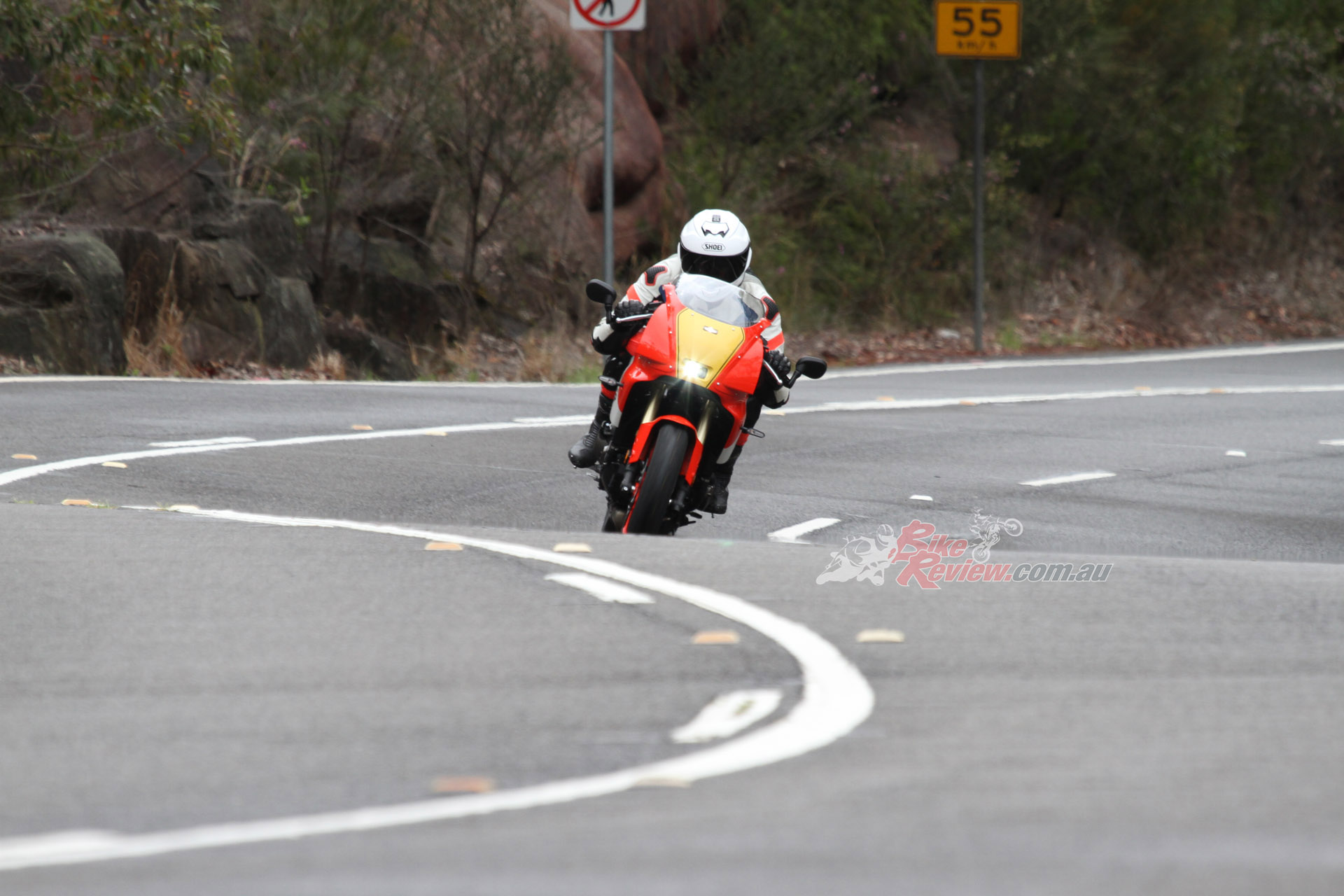
A flick to the right and a flick to the left through esses does require more effort than on the stock XSR.
When pushing hard or on a track, I imagine some riders might find the stock setup slightly under-done suspension-wise. But for fast road use, it strikes a good balance between comfort and performance. Braking performance is solid, without being YZF-R1-like. The GP gets an upgraded 16mm Brembo master-cylinder, which provides excellent feel and initial bite. The small 298mm discs and Nissin radial calipers deliver predictable braking power, and the IMU-controlled ABS is unobtrusive. The rear brake is serviceable but lacks the feedback of the front setup. Mine felt a bit glazed during testing, so it may improve with time or a pad swap. Overall, the brakes are good without being amazing.
While the XSR900 GP is aimed more at the weekend scratcher or occasional track day punter than long-distance tourer, it’s still surprisingly capable day-to-day. The engine is smooth and tractable at low revs around town, or in urban areas, but out on the open roads it is comfy and will sit on 110km/h all day long on cruise control.
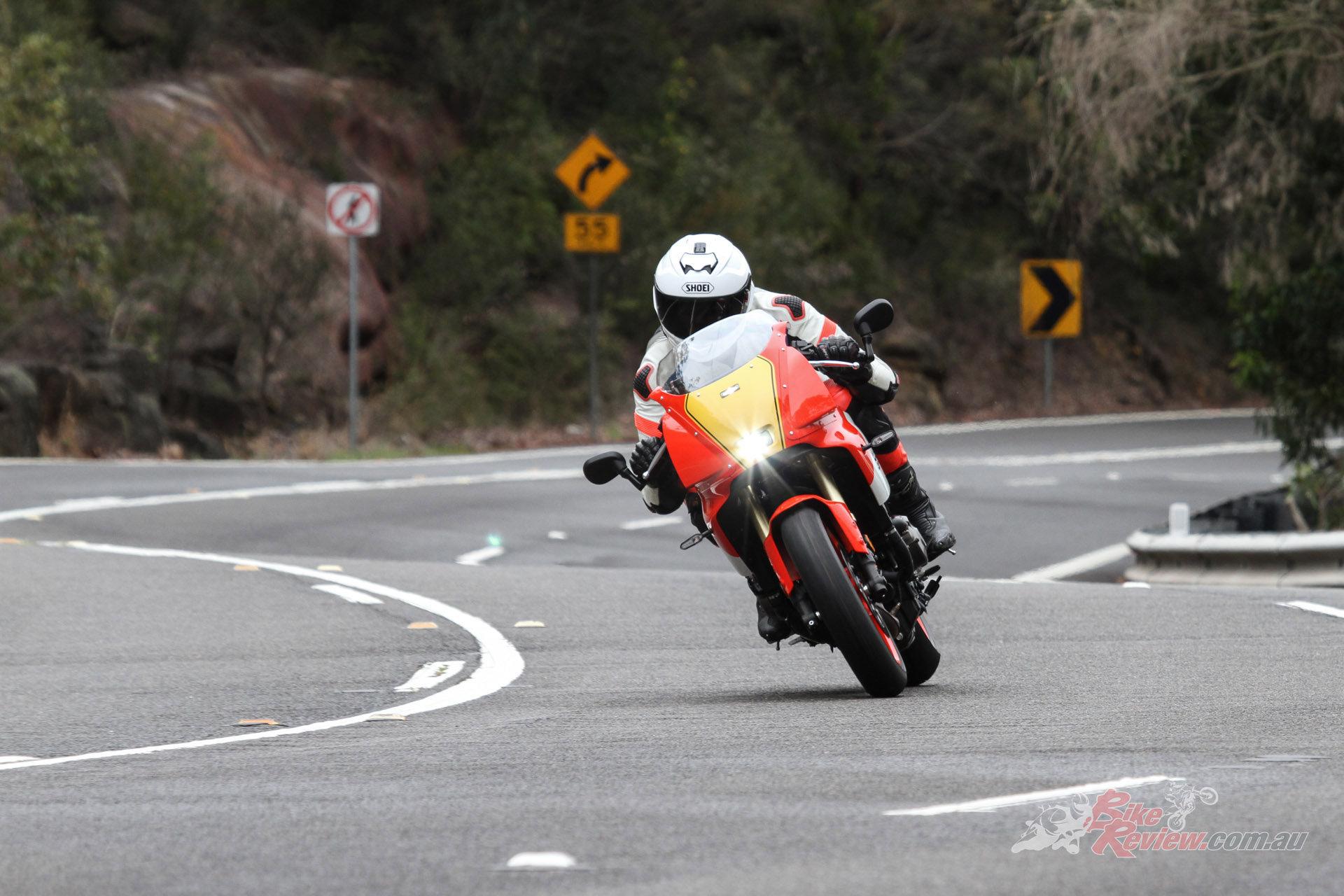
“It was magic to feel 17 again for an hour or so… That experience alone makes this a specials bike…”
The firm seat and clip-on bars might be a bit much for daily commuting or long hauls, but for most weekend riders the riding position is tolerable. On the freeway, that mentioned cruise control makes a big difference, and there’s just enough wind protection to stop you feeling like a kite at 110km/h. Fuel economy is very respectable, I averaged 4.2L/100km on my 400km highway trip, which gives around 250-270km from the 14-litre tank depending on conditions.
The 2024 Yamaha XSR900 GP takes the already brilliant XSR900 and dials the styling and rider engagement up to 11 for anyone over 40. It’s a rolling homage to Yamaha’s golden era of GP racing—yet it’s not pretending to be a classic. It’s not a museum piece. It’s a weapon. A celebration of what motorcycles were and what they are now., wrapped up into one package.
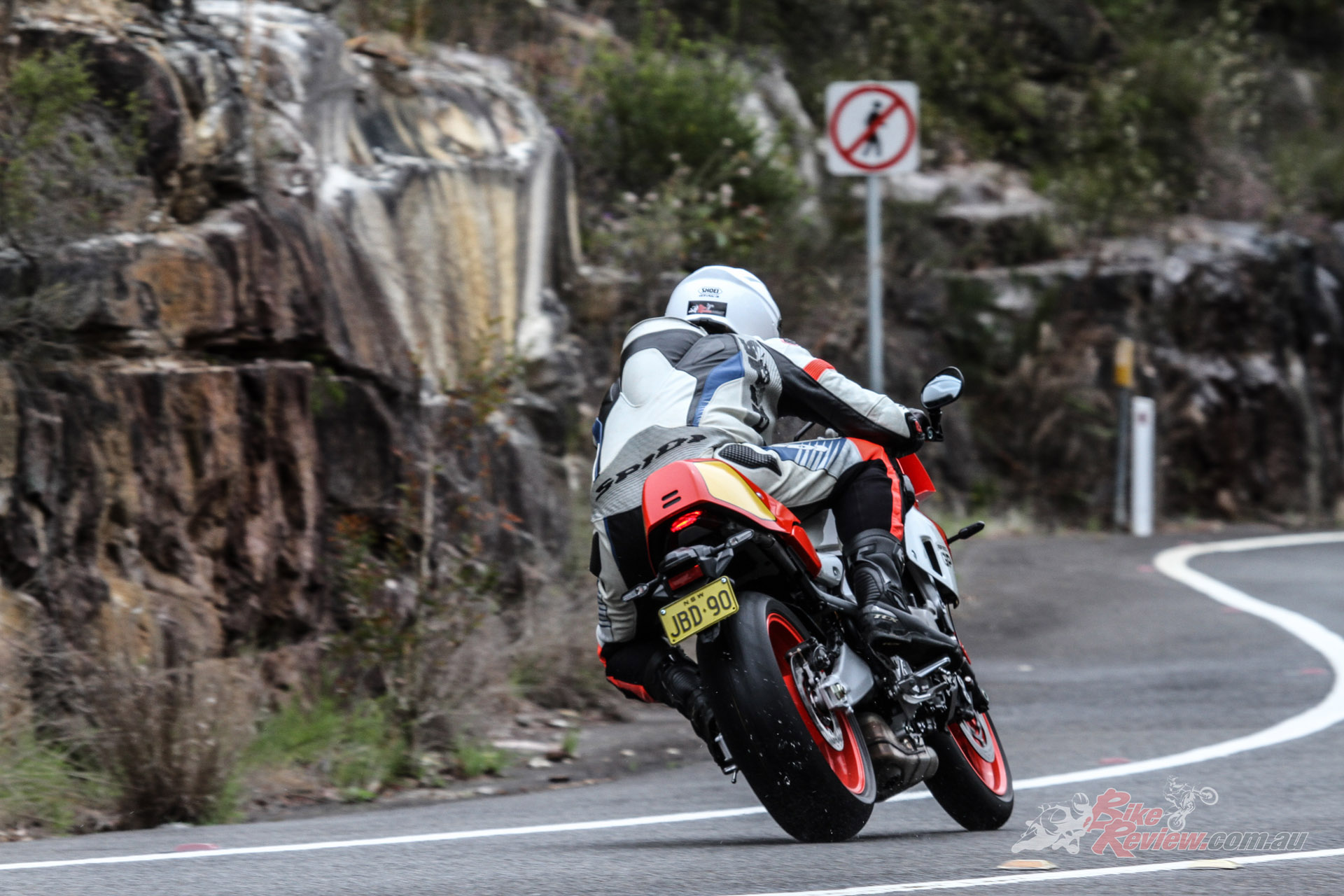
Rain Mode is fantastic. I had it set for this part of the shoot when the rain came down, and with the CP3 tractability, the excellent Bridgestone tyres, and the electronics, the XSR900 GP is a great wet weather bike.
It’s not for everyone. Some will still prefer the upright ergonomics of the base model, or the full touring potential of the Tracer 9 GT. But if you want a bike that looks like it just jumped off a Marlboro Series poster and rides like a 2025 sport naked, this is it.
With Yamaha Australia currently offering a sub-$20k ride away deal until June 30, it’s more tempting than ever…
And with Yamaha Australia currently offering a sub-$20k ride away deal until June 30, it’s more tempting than ever. For riders who grew up drooling over FZR750s and TRX850s, or anyone who wants a proper modern sportbike wrapped in heritage styling, the GP delivers.
Doing this XSR GP shoot with Heather, I rode up and down the same stretch of Old Road I used to ride my RZ250 up and down after school, when I would imagine I was on Wayne Rainey’s YZR500… I fell into that moment again on the XSR GP, it was magic to feel 17 again for an hour or so… That experience alone makes this a specials bike…
Tech Talk Yamaha XSR900 GP
Racing runs deep in Yamaha’s DNA. From the golden era of Grand Prix dominance with legends like Kenny Roberts and Wayne Rainey to cutting-edge tech in modern performance bikes, Yamaha’s racing heritage continues to shape its future. For 2024, that spirit is alive and well in the stunning new XSR900 GP – a bike that pays homage to Yamaha’s most iconic race machines while embracing the latest in engineering and electronics.
Draped in the iconic Legend Red livery inspired by Yamaha’s 500cc GP bikes, including those piloted by Rainey, the XSR900 GP merges 1980s Grand Prix styling with high-performance componentry and advanced electronics. Think authentic yellow number boards, a boxy rear cowl, and angular front fairing – all hallmarks of the era. But beneath the bodywork lies thoroughly modern performance.
At its heart is Yamaha’s celebrated 890cc CP3 triple, making 87.5kW at 10,000rpm. It’s the same torquey, smooth engine as in the XSR900, but the GP’s wind-tunnel tested fairing adds better aerodynamics, improving both acceleration and top speed. Twin ducts in the side panels also help maximise radiator cooling. Meanwhile, a colour-matched seat cowl and seat stopper add to the genuine racebike silhouette.
XSR GP Tech Highlights
-890cc CP3 engine with 87.5kW peak power
-Retro fairing and bodywork inspired by 1980s GP machines
-Clip-on handlebars and higher-set adjustable footpegs
-Reinforced subframe and tuned steering stem for sharper handling
-Fully adjustable KYB suspension front and rear
-Six-axis IMU with lean-sensitive rider aids (TCS, SCS, LIF, BC)
-Yamaha Ride Control with custom and preset riding modes
-5-inch TFT dash with Garmin nav, Bluetooth and USB-C connectivity
-Brembo radial master cylinder, cruise control, and 3rd-gen quickshifter
The new upper cowling and cockpit setup borrow heavily from Yamaha’s historic TZ250 racebikes. The fairing is mounted using a tubed structure and straight dash brackets, creating a period-correct rider’s view. A nut structure on the fairing stay, complete with beta pin fastener – a first on a road-going Yamaha – underscores the commitment to authentic retro detail.
But don’t let the old-school aesthetic fool you – this thing is loaded with high-spec gear. The clip-on handlebars shift the rider forward into a sportier position, supported by a thicker, more ergonomic seat. Adjustable aluminium footpegs (factory set in the higher position) and a reinforced sub-frame help manage the new riding posture, while the aluminium steering stem shaft fine-tunes front-end feel.
Handling is dialled in via adjustable KYB suspension. The 41mm upside-down forks offer preload, compression, and rebound damping adjustability. Out back, the forward-inclined KYB shock connects to a link-type rear suspension with easy remote preload adjustment. Braking is handled by a Brembo radial master-cylinder, providing stronger feel and response at the lever.
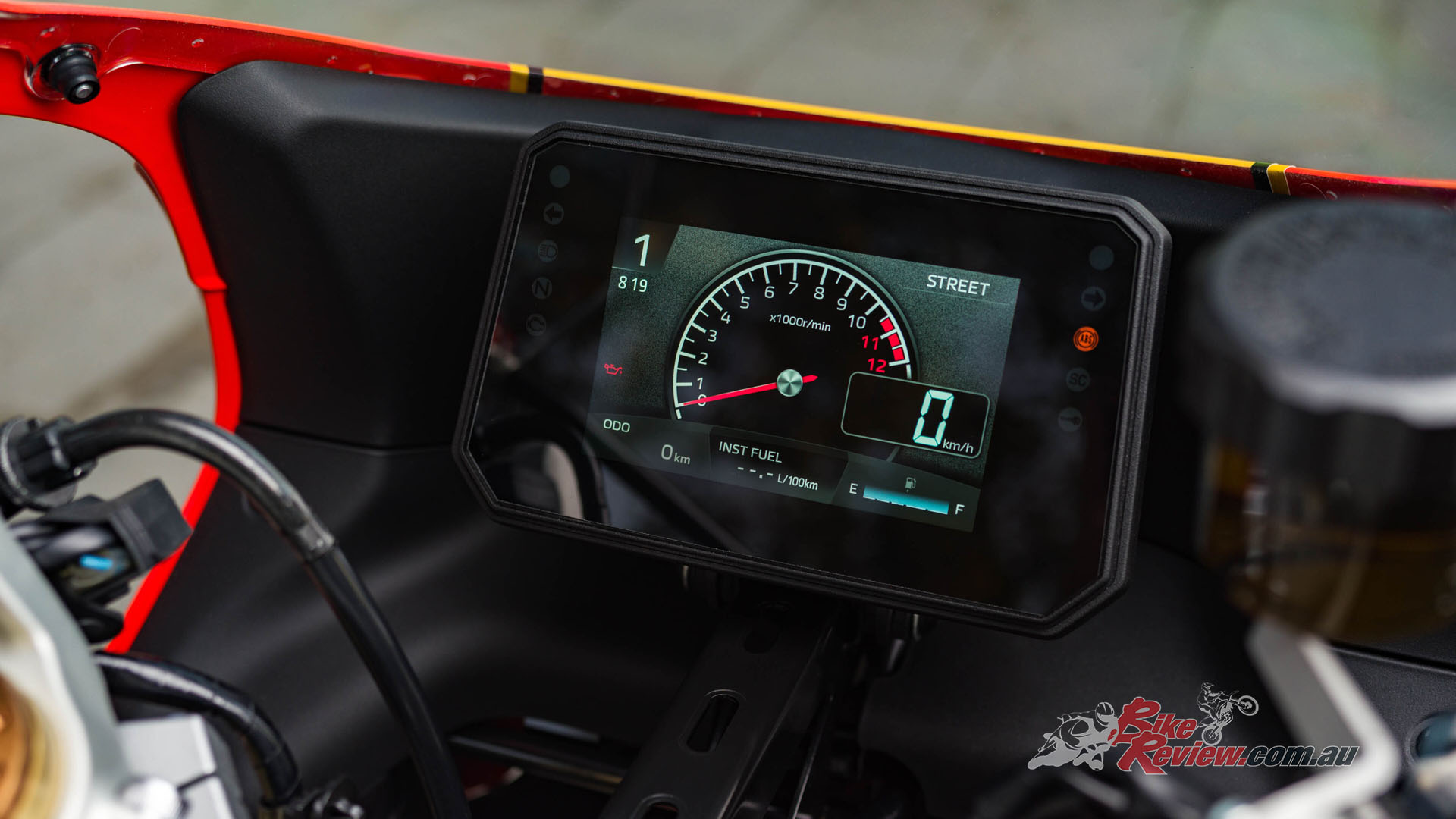
Further maintaining the mix of nostalgic style with the latest in high performance technology, XSR900 GP riders can customise their riding experience via Yamaha Ride Control (YRC).
Underpinning all this is Yamaha’s latest six-axis IMU, developed from the R1. It governs a full suite of lean-sensitive rider aids, including Traction Control, Slide Control, Wheelie Control (LIF), and Brake Control (BC). Yamaha’s Ride Control (YRC) system offers three preset modes – SPORT, STREET, and RAIN – plus two customisable profiles via the MyRide app, allowing riders to tailor throttle response, power, and intervention levels to suit conditions and preference.
Tech lovers will appreciate the 5-inch full-colour TFT dash, which features four display themes including a race-inspired analogue-style tachometer. Riders can connect a smartphone via Yamaha’s Communication Control Unit (CCU) to access Garmin StreetCross turn-by-turn navigation, music, calls, and message notifications. A USB-C port near the dash adds charging for devices on the go.
Other thoughtful touches include smart switchgear with soft- and full-click indicator functionality, plus an Emergency Stop Signal (ESS) that activates hazard lights under heavy braking. The XSR900 GP also debuts Yamaha’s third-generation quickshifter, allowing for clutchless upshifts and downshifts – enhancing both performance and everyday usability.
All of this rides on Spinforged wheels wrapped in Bridgestone Battlax Hypersport S23 tyres, further reinforcing Yamaha’s XSR blend of old-school cool with modern high-performance capability. A full range of accessories will be available including a lower fairing, tinted screen, tail tidy, and an Akrapovič exhaust system, allowing riders to personalise their GP even further.
2025 Yamaha XSR900 GP Specifications
Price: $19,499 R/A) until June 30 2025 (RRP $21,499 R/A)
Warranty: Two-years unlimited km
Colours: Legend Red, Power Grey
Claimed Power: 87.5kW@10,000rpm
Claimed Torque: 93Nm@7000rpm
Wet Weight: 200kg
Fuel capacity: 14L
Fuel Consumption Claimed: N/A
Fuel Consumption (measured): 4.8L/100km
Engine: Liquid-cooled, four-stroke, DOHC, Cross plane triple, 78.0mm x 62.1mm bore x stroke, 889cc, 11.5:1 compression, three-into-one exhaust Gearbox: Six speed Clutch: Wet, multiple disc
Chassis: Frame: Aluminium Deltabox frame, clip-on handlebars
Rake: N/A Trail: N/A
Suspension: USD 41mm telescopic KYB fork, fully adjustable (f), travel 130mm, KYB monoshock, adjustable for preload and rebound (r), travel 131mm.
Brakes: Twin 289mm discs with four-piston radial-mount calipers, Brembo master-cylinder, cornering ABS(f), Single 245mm disc with single-piston caliper, cornering ABS (r)
Wheels & Tyres: 10-spoke Spin Forged alloy wheels, 120/70 – 17 and 180/55 – 17 Bridgestone S23 tyres.
Dimensions:
Seat height: 835mm
Ground clearance: 145mm
Overall width: 860mm
Overall Length: 2160mm
Overall height: 1180mm
Wheelbase: 1500mm
Instruments & Electronics: Full-colour TFT dash, Cornering Traction Control System [TCS], Slide Control System [SCS], Lift Control System [LIF] and Cornering ABS (BC), Engine Modes (Street, Sport, Rain, Custom), Cruise.
Ratings | Bike Review | Yamaha XSR900 GP Road Test


